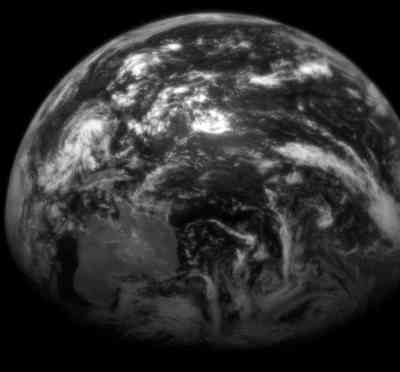The Mercury Messenger spacecraft flew past Earth this weekend to get a boost from its gravity that will allow it to move faster through the inner solar system.

The Earth as photographed from the Mercury Messenger spacecraft
The Mercury Messenger (MErcury Surface, Space ENvironment, GEochemistry, and Ranging) spacecraft, on its way to the first study of the first planet from the Sun from orbit around it, passed by Earth this weekend to get a boost from its own gravity that will allow it to move faster through the system The inner sun.
Mission managers at Johns Hopkins University's Applied Physics Laboratory in Maryland say the spacecraft's systems are working flawlessly. The spacecraft flew past Earth and reached its closest point 2,347 kilometers above central Mongolia at 3:13 a.m. EST.
The spacecraft used Earth's gravity to change its trajectory. Now its average orbit is 30 million kilometers closer to the Sun. The maneuver launched her towards Venus, where she will also perform a similar gravitational maneuver in about a year.
The spacecraft was launched on August 3, 2004 from Cape Canaveral, Florida. Naturally, it will help with solar energy. Despite the relative proximity between the two planets, the spacecraft will travel 7.9 billion kilometers, which includes 14 loops around the sun. Messenger will pass Venus twice and Mercury three times before beginning its orbit.
The Venus flybys are planned for October 2006 and June 2007 and will use the planet's gravity to guide Messenger into Mercury's orbit. Flybys of Mercury are planned for January 2008, October 2008 and September 2009 to help the spacecraft reach the speed of the planet. In the end, the spacecraft will perform a maneuver in March 2011 and only then will it begin a one-year survey of the planet Hama.
"The near-Earth pass is the first in a series of critical missions during MESSENGER's tortuous journey toward Mercury," said Shawn Solomon, principal investigator of the mission from the Carnegie Institution in Washington. "Not only did the approach help the spacecraft refine its direction for the next maneuver, but it also created an opportunity to calibrate some of the scientific instruments."
MESSENGER's main camera took several pictures during the approach - of the Earth and the Moon. In addition, the camera also took several color photos ranging from South America to a complete rotation of the Earth. The members of the scientific team will combine the images with a video describing the separation of Messenger.
In addition, the Atmospheric Composition Spectrometer made several measurements of the Moon in conjunction with the Malma observations. In addition, the instruments that measure the particles and the magnetic field spent several hours measuring the Earth's magnetosphere. The scientific team will download the images and data from the spacecraft using NASA's Deep Space Network during the coming weeks and will continue to evaluate the instruments' performance.
MESSENGER will perform the first comprehensive study from the orbit of Mercury, the planet that is the least studied of the terrestrial planets (which of course also include Venus, Earth and Mars). During one Earth year (four Mercury years) Messenger will provide the first images of the entire planet. It will also collect detailed information about the composition and structure of Mercury's crust, its geological history, the nature of the atmosphere and magnetosphere, the composition of the core and the materials at the poles.
The Mercury Messenger satellite website
to a NASA press release
Additional articles on the subject:
Mercury Messenger - a spacecraft on its way to the planet Hema (Popular Science)
Mercury Messenger's Israeli connection: a Ricker micro-fridge
